
ITSM Best Practices: What to Look for in an End-User Portal
Did you know that, according to HDI, a support call costs $22 compared to self-service which costs just $2 per incident? As companies look for
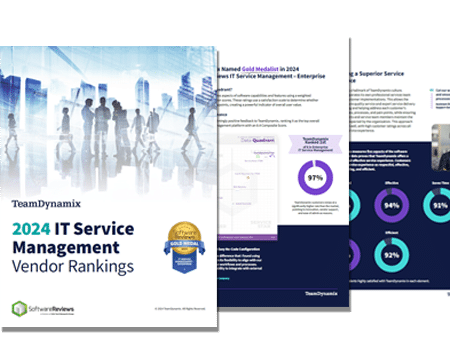
The Info-Tech ranking report offers a unique view of the market based entirely on in-depth customer interviews. Download the Info-Tech ITSM Quadrant and Customer Viewpoint report today.

We’ll show you some of our best situations and show you exactly how to execute them to get immediate results. The best part is, iPaaS tools often feature easy-to-use click and drag functionality, meaning you don’t need a dedicated employee building integrations and workflows.
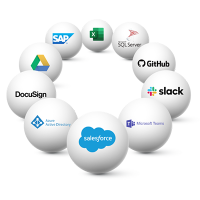
System Integrators, Value Added Resellers, Technology Providers, and Buying Consortiums can benefit from a partnership with TeamDynamix.

The Info-Tech ranking report offers a unique view of the market based entirely on in-depth customer interviews. Download the Info-Tech ITSM Quadrant and Customer Viewpoint report to gain a better understanding of key vendor strengths and emerging market requirements.
What is IT Service Management? IT Service Management (ITSM) is a framework of best practices for IT. It is used to manage and deliver IT services to customers or end-users. ITSM links IT services with the goals of the business. It ensures that IT services are managed efficiently, effectively and with customer satisfaction in mind.
The ITSM framework covers a broad range of IT activities. This includes incident management, problem management, change management, release management, service level management and more.
For IT Service Management to be successful, you need to have the right mix of people, processes and technologies. ITSM ensures that IT services are implemented, managed and delivered in a way that meets a business’s needs. It also provides added value to employees, clients, consultants and other interested parties. As such, your ITSM strategy should be focused on the following goals:
Organizations in many sectors, such as healthcare, government, technology, financial service and corporate, use IT Service Management. This helps standardize IT services and create value for end-users that are specific to their industry.
ITSM has led to the development of IT management frameworks. These frameworks can be used in both centralized and decentralized systems. The most comprehensive and widely used is the ITIL framework.
ITIL stands for Information Technology Infrastructure Library and refers to a specific framework for ITSM. ITIL is a set of specific methods, practices and processes for managing the organization’s IT operations and services.
With ITIL, the focus is on ensuring that IT services can keep pace with business needs. The ITIL framework covers all aspects of IT infrastructure, from the foundation itself to its management and services.
ITIL implementation, like ITSM, helps organizations of all sizes to maximize and optimize enterprise value using information technology for the benefit of their customers.
ITIL is based on principles that focus on value creation and continuous improvement, which can take a variety of forms. In fact, several iterations of the ITIL framework have been released since its inception in the 1980s, each one improving on the previous to describe a balanced and holistic approach to service management.
The IT Service Management landscape is always changing, and emerging trends continue to shape the discussion around ITSM. As such, there is no one-size-fits-all approach to service management and delivery.
An ITSM or ITIL approach does not have to represent an administrative burden but instead should be used flexibly to meet the unique needs of a given organization. Again, the goal of ITSM is to apply service management principles in a way that improves the entire organization.
No matter your approach, implementing ITSM best practices enables organizations to standardize and optimize the way they respond to the ever-increasing demand while keeping operational costs low and customer satisfaction high.
Dusty Borchardt, Business Systems Manager for Oklahoma City, said that they adopted the ITIL framework more than 15 years ago but hadn’t achieved what they’d hoped they could through their service delivery until recently. Why? Well, the right ITSM tool for your organization can make all the difference.
He explained that they’d had effective processes in place for a while, but they “haven’t had a decent toolset to manage them” until they utilized TeamDynamix’s ITSM platform.
“TeamDynamix has brought simplicity to our operations,” Borchardt says. “This is the first IT Service Management platform we’ve implemented that everyone loves to use.” For Oklahoma City, TeamDynamix was the right fit.
This is why finding the right vendor for your organization can be so critical to your ITSM success.
To help, you can get tips and questions to ask vendors during your evaluation process here.
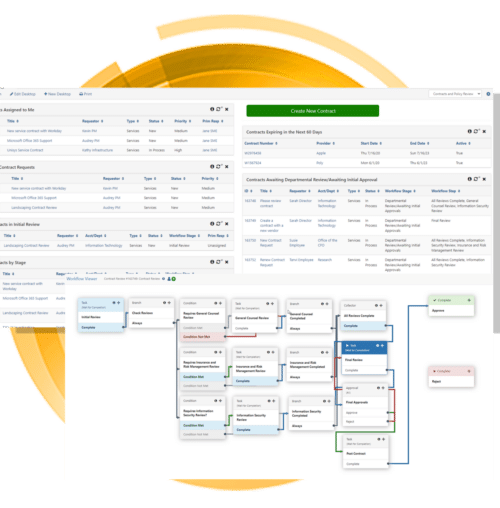
It’s easy to confuse the term IT Service Management with Enterprise Service Management or ESM. ESM is simply an extension of the ITSM principles to entire organizations, beyond the IT department and its services. By adopting an ESM strategy, companies can provide a unified service experience, breaking down silos between departments and fostering collaboration.
In fact, ESM is the most widely used and clearly defined framework for IT management. Think of it this way: when a non-IT department uses a traditional ITSM process to provide a service or solve a problem, it is a reuse of an existing process that has just been reinvented.
Inspired by ITIL-4, ESM is now at the heart of the IT management approach to the provision and management of IT services. It goes beyond an ITSM strategy and brings it to bear on the various teams and departments within IT.
As ITIL becomes more popular, more and more people will realize that ESM and ITSM best practices can and should be used in the business functions of the organization that provides services.
To envision what ESM can do for your organization close your eyes and imagine a central hub – like an Intranet. You go there and there are big buttons for things you want to request – like “Request IT Service” or “Request a Parking Permit.” There could even be a library of information so that you can read about how to potentially purchase your own monitor and chargeback, or you can read about how to fix your blinking voicemail light.
This central hub is your company’s core brain – it’s a library or knowledge base of critical information with embedded “HELP ME” buttons that will automatically route your service request to the right place.
Human Resources often serves as a great use case example for ESM because literally, everyone in the company relies on HR for both information and service delivery.
Services could be a request to change a name, to add a dependent, to change an address or even to report a compliance issue. If you were to go to the hub and enter the HR hub area, there could be a combination of indexed articles that will inform, as well as hot buttons.
On the other end, HR can easily configure the hot buttons to route information or even trigger workflow actions. You can read about more HR use cases here.
But other departments can benefit from ESM as well. Here’s a great blog that details what ESM can look like within a marketing department.
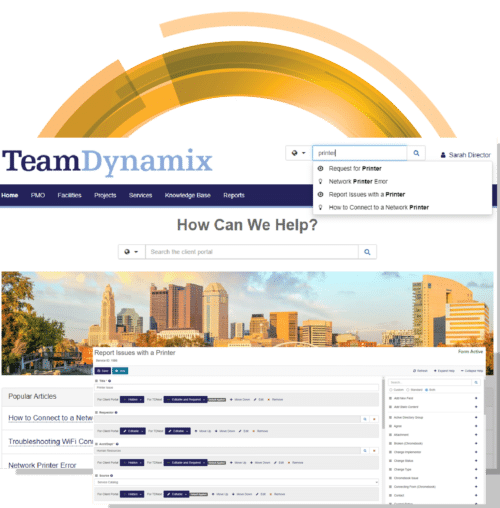
ITSM has changed the way IT departments behave – IT no longer operates as just system integrators but as service providers working to ensure that the company can satisfy customer and employee needs as effectively as possible.
To do this, the ITSM tool you use should deliver powerful reports that can help identify trends, eliminate bottlenecks and improve the quality of services provided.
Specifically, you should look for a fast, intuitive ITSM tool that integrates with third-party platforms and facilitates:
When evaluating ITSM software for your organization, here’s a list of features and functionalities that are non-negotiable:
By measuring your ITSM options against this list, you can find a tool that can be customized to fit your needs and scale for the future.
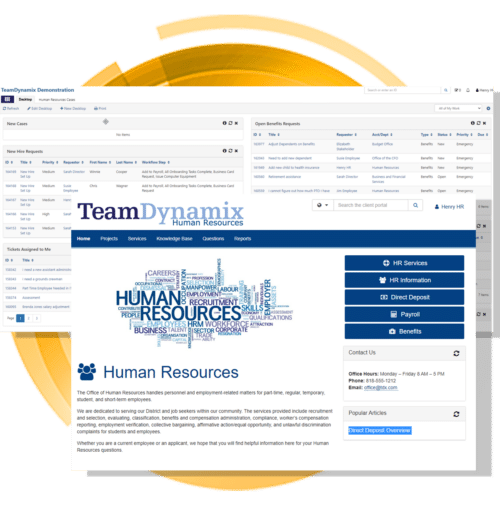 To help find a flexible, easy-to-use ITSM tool, consider the following questions during your vendor evaluation:
To help find a flexible, easy-to-use ITSM tool, consider the following questions during your vendor evaluation:
The best out-of-the-box IT Service Management software is the one that supports your desired approach and is easy to use for your team.
The service desk is often the frontline for capturing changing business needs and requirements. When you combine your ITSM/ESM with Project Portfolio Management (PPM) you can better understand your resource capabilities and engage in true resource capacity planning.
With resource capacity planning you get a big-picture view of your entire organization, allowing you to balance workloads across projects and support – not just IT; and to see the different types of work that need to be done at any given time.
As a result, all work can be completed more effectively and efficiently as employees and teams are focused on work that plays to their strengths. And because you have a full view of the work and the time it will take; you can avoid overcommitting or underutilizing your resources across the entire company.
Hema Nekkanti, project management office manager for the City of Sunnyvale, touts the benefits of bringing ITSM and PPM together on a single platform, “With one platform now we can actually see the tickets that are being worked on as well as the projects that are in the pipeline,” she said. “This gives us the ability to actually allocate the resources appropriately, and there’s no resource conflict.”
CIO Kathleen Boutte said she also highly values the resource management visibility she gets from TeamDynamix using ITSM and PPM together, “We really needed that visibility, and it’s why this has been such a great tool for us. Having both the service side and the project side means I can see whether my team is working on a ticket or a project and how busy are they. I get visibility into their availability, and I can forecast more accurately to know that I am not overworking staff or that we’re not just sitting on the bench twiddling our thumbs.”
In addition, adding enhanced integration and automation to your IT Service Management/ESM practices through the use of iPaaS is a great way to free up resources and boost efficiencies. By investing in smart service management for your organization, you’re investing in service management that supercharges your entire enterprise and allows everyone to interact in real-time.
When you combine ITSM, PPM and iPaaS on a single platform you can automate tasks, both simple and complex, and connect disparate systems throughout your organization – all through a codeless platform, meaning anyone can use it. You no longer need to be bogged down by repetitive or mundane service requests.
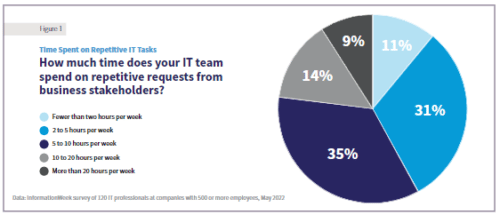
Toil is a word popularized by Google that refers to work that tends to be manual and repetitive but can be automated. And having high levels of toil throughout your organization can lead to problems including burnout, human error and employee discontent.
At Pima County, one of the goals of bringing on TeamDynamix for ITSM and iPaaS is to reduce toil.
“People feel so much more empowered and have so much more worth when they are doing things that are intellectually rigorous and challenging versus when they are just repeating the same mechanical actions over and over and over with very little thought,” Mark Hayes, information technology leader at Pima County, said.
“Our IT service desk is our entry point to our entire IT organization, and we want our employees to graduate out of this area into other roles within our organization – to become network technicians, client services, desktop technicians, developers and project managers,” he continued. “If all they’re doing is handling tickets and doing the same mundane, manual tasks over and over that’s not particularly great training. So investing in tools that allow our employees to engage in meaningful work is something that’s important to us as an overall IT organization.”
With TeamDynamix now in place, Pima County is looking to automate and integrate as much of the manual ITSM processes into workflows as they can.
“The drudgery of working through mundane, repetitive tasks doesn’t exist just in IT,” Hayes said. “I think the more we can reduce toil within the departments that we support, the more people are going to buy in and understand the value of what we’re trying to achieve. There’s nothing like success to breed more success, and once other departments see the benefits they’re going to want these tools too.”
When contemplating the use of automation and integration as part of a broader Enterprise Service Management strategy, it’s important to consider the different ways a tool like iPaaS can be used to extend ESM even further.
At Winston-Salem University, they’ve done just that. Derrick Hargrove and his team in the Office of Information Technology, are using iPaaS to automate processes throughout the University that directly impact service resolution times whether in IT, the Office of the Registrar, the financial aid office or human resources. Hargrove said the university started building iPaaS workflows to address various challenges they had with both system access and access to various apps and software provided to students, employees and faculty at the university.
“By creating these workflows within iPaaS we are able to save a significant amount of time,” Hargrove said. “Previously we’ve had situations where system access has held up a ticket so having the automated approval and access granted through iPaaS has helped us avoid those issues. And when you have people who need certain access or software to do their jobs, it’s nice to be able to provide that almost instantaneous resolution. It’s been a big win for us.”
The university has flows in place to grant system access based on different groups within Active Directory. Those same groups are utilized to run flows to grant access to things like Microsoft Teams and Adobe Creative Cloud.
If you want to see how organizations are supercharging their IT service management read our latest eBook Automate IT – A Playbook for Supercharged ITSM.

TeamDynamix Ranked #1 in ITSM
ITSM platforms are quickly evolving, download this report to understand key drivers for top of quadrant vendors. Use this guide to help you during your selection process. Download the Info-Tech ITSM Quadrant and Customer Viewpoint report to gain a better understanding of key vendor strengths and emerging market requirements.

Did you know that, according to HDI, a support call costs $22 compared to self-service which costs just $2 per incident? As companies look for
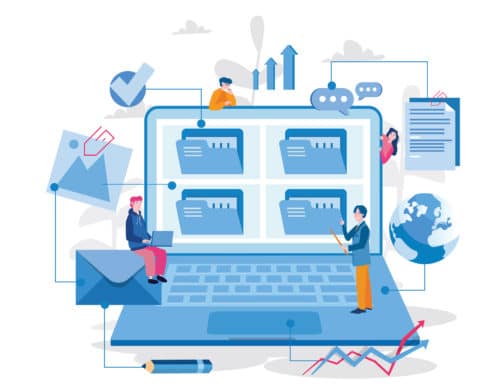
A service catalog initiative can be deceptive. At first glance, it seems like a simple process of listing all the services your organization offers to
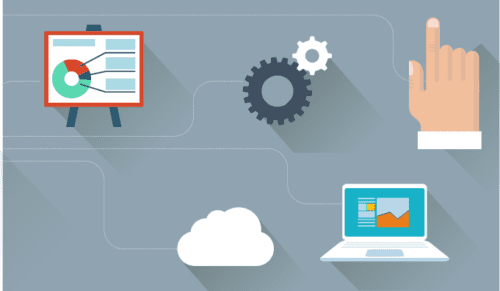
ITSM vs ITIL: What’s the Difference? If your organization wants a better understanding of how it currently provides IT support, it is crucial to understand the
TeamDynamix’s award-winning SaaS cloud solution offers IT Service and Project Management together on one platform with enterprise integration and automation.
[email protected]
(877) 752-6196
Contact Us
